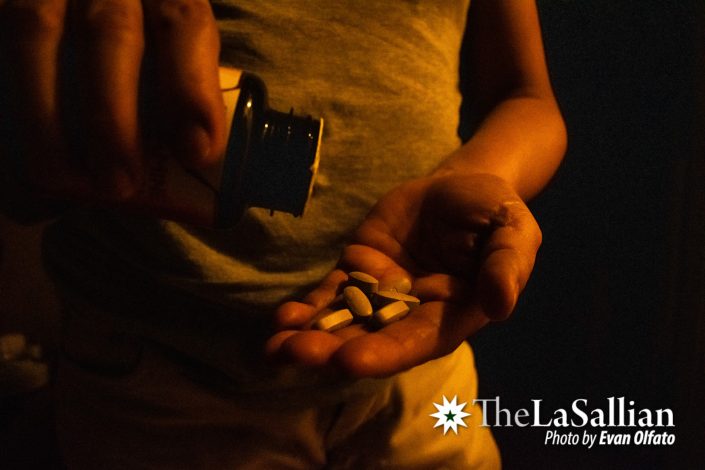Lasallians undergo the Periodic Health Examination as part of their enrollment requirements every year to check if they are in a healthy condition. Students are subjected to a barrage of tests, which include x-ray and blood pressure checks. But there is one test that sticks out among the others: the mandatory drug test.
As the DLSU Student Handbook provides in Section 1.20.3, all students are required to undergo drug testing. This policy, which forms part of the Lasallians’ Fight A gainst Drugs (LFAD) Drug Testing Program (DTP), has been in effect since Academic Year (AY) 2016-2017, when it was first made mandatory; in the AY prior, random testing was implemented for ID 115 students only.

Legal requirements
On a national level, all secondary and tertiary educational institutions are subjected to Republic Act 9165 or the Comprehensive Dangerous Drugs Act of 2002, which stipulates that random drug testing should be implemented and that programs for substance abuse deterrence should be enacted by schools.
DLSU, however, conducts the test for all of its students—in contrast to a randomly selected sample—because it views the process as part of the University’s health program, according to Nelca Villarin, Dean of Student Affairs.
The Health Services Office (HSO) conducted mandatory drug testing for ID 115, 116, and 117 students last May 27 to June 26. To the surprise of others, ID 114 students and below were also given their own round of testing last July 9 to 13, effectively ensuring that everyone was tested.
To enforce the rule, refusing to undergo testing is categorized as a minor offense, according to Section 5.3.2.28 of the handbook. Drug testing is also one of the clearance requirements for enrolling in the following AY.
Villarin clarifies that the purpose of testing is not to criminalize students. Rather, it is to ensure their safety and well-being. “Since our purpose is to provide support and help to the students, we might as well have everyone tested so that we would really be able to know who would need assistance,” she explains.
Testing for illegal substances
Among the various drug testing methods, such as saliva, sweat, or blood screening, LFAD DTP chose to use urine samples for analysis. HSO Director Dr. Lily Cabuling believes this choice to be the best because it is painless, easy, and cost-effective.
HSO enlists the help of an accredited service provider to facilitate testing. In addition, it sets the dates, selects the venue, and encodes the data of the students for clearance. Once results arrive, the office conducts assessment and interpretation.
If a student is tested positive for illegal substances, the sample will be tested again for confirmation. A letter regarding the confirmatory test will be sent to the student and his legal guardians. If the sample is once again positive, the DSA will invite the student and his guardians to discuss appropriate intervention plans.
It is important to note, however, that students who do end up testing positive are not reprimanded for the result. As the student handbook specifies, “Positive confirmatory drug test result shall not be a ground for any disciplinary action against the student and should not be reflected in any of his/her academic records.” The results are also not allowed to be used in any form of legal action against the student.
Villarin recounts that over the past years, not a single student tested positive for illegal substances. But she clarifies that this might not indicate that all students do not take drugs. Since testing schedules are given in advance, it is possible that students may attempt to appear “clean” prior to testing, Villarin elaborates.
Providing support
If students want to seek help for substance abuse, they can approach the Office of Career and Counseling Services (OCCS). According to OCCS Director-OIC Elaine Aranda, the office views substance abuse not as a problem on its own, but as a manifestation of something else that is bothering a student’s life.
Right after seeking help, the student is led to the intake interview. There, assessment begins. The counselor will try to check the student’s social, academic, and family background in order to understand what the student is facing.
“We listen and we bring back that story (students’ experiences) to them to make them more aware,” Aranda says. With this, she hopes that through consultations, students would find clarity and understand how they ended up involved in drugs.
Over the course of several sessions, counseling should provide the student with a “more empowered self”. Aranda is of the firm belief that by strengthening “emotional resiliency”, students would be less susceptible to dangerous vices.
History of involvement
In an effort to combat substance abuse, the University has provided different forms of campaigns. These include education efforts and formative programs—all conducted by different offices such as the HSO, SDFO, and OCCS. Villarin also highlights the mandatory drug test as a means of dissuading students from using illegal substances.
Yet, DLSU students being tied to drug-related incidents is not new. Last March 18, the Makati City Police seized and arrested two suspects for possession of suspected party drugs and crystal methamphetamine worth an estimated P1.5-million. The suspects were identified as students from De La Salle-College of St. Benilde and DLSU.
In 2016, a freshman psychology student was one of the many casualties in the Close Up Forever Summer music festival. Autopsy results showed that the student suffered a massive heart attack, allegedly from intaking drugs at the event.
Further, in 2014, a DLSU student, whom the Philippine Drug Enforcement Agency classified as a “high-value target”, was arrested in a buy-bust operation at One Archer’s Place, seizing 223 ecstasy tablets worth an estimated P334,500.
Regarding this, Villarin cautions that there is no such thing as a foolproof method. “Kahit anong gawin ng University, at the end of the day, it’s the decision of the students,” she says. (Whatever the University does, at the end of the day, it’s the decision of the students.)
